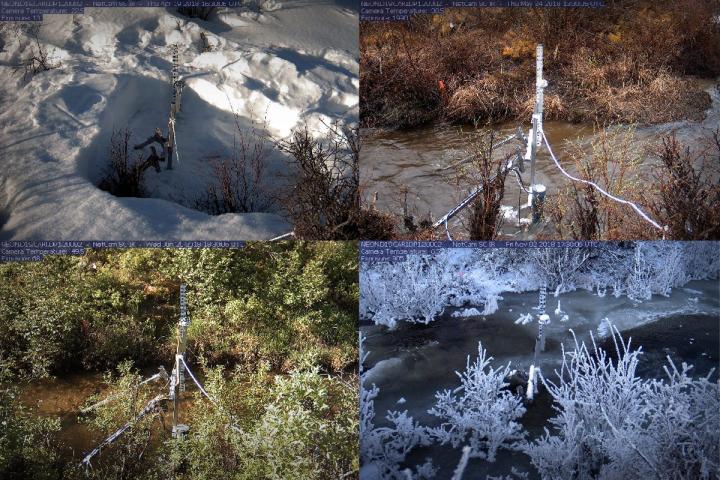
Credit: PhenoCam Network
Carbon serves as the building block of life — it cycles through every organism, the environment, and the atmosphere to make Earth capable of sustaining life.
Freshwater ecosystems may cover less than one percent of the Earth’s surface, but they play an active role in the global carbon cycle through carbon respiration and sequestration.
Through photosynthesis, terrestrial trees and plants take in carbon dioxide (CO2) and water to produce carbohydrates and oxygen. When plants die, the organic carbon that makes up their leaves, stems, and roots decays in the soil. But landscapes are “leaky” — some carbon seeps into the groundwater and travels through streams and rivers before being cycled back into the atmosphere. How carbon moves through a landscape and across land-water boundaries has implications for water quality and freshwater food webs.
Erin Hotchkiss, an ecosystem ecologist and assistant professor in the Department of Biological Sciences in the College of Science, and her collaborators received a $1.12 million grant from the National Science Foundation (NSF) to study how carbon moves across land-water boundaries and the multi-scale consequences of terrestrial carbon losses for freshwater ecosystems and global carbon budgets.
“Streams are the gutters and recycling centers of a landscape — what we see in terms of water quality and biology in streams reflects not only what’s happening in the waterway itself, but it is also an indicator of what is happening on the surrounding landscape,” said Hotchkiss, an affiliated member of the Global Change Center, housed within the Fralin Life Sciences Institute. “We can’t understand the fate of terrestrial carbon without linking landscapes with their waterways.”
Carbon cycling in terrestrial and aquatic ecosystems are rarely studied together. Hotchkiss and her team are working to understand how materials and energy move across ecosystem boundaries and how that alters biological functions, such as metabolism, and greenhouse gas emissions in streams. Stream metabolism, the balance between photosynthesis and respiration, is a fundamental process that contributes to water quality and food web production.
Forests are carbon sinks, or natural carbon reservoirs, but streams play an opposite role in the carbon cycle — they are often carbon sources that emit CO2 and methane to the atmosphere. When co-located streams and forests are considered as a single unit, scientists can help fill in a critical knowledge gap in the global carbon budget by addressing a key question: What is the fate of terrestrial carbon? To address this, Hotchkiss’ research will link measurements of how much carbon is stored in forests after photosynthesis, how much leaks into streams, and how much is respired and emitted by streams.
“From global budgeting perspectives, we’re still missing this concept of landscapes leaking carbon across terrestrial-aquatic boundaries,” said Hotchkiss. “Being able to quantify and propose a framework for including how much carbon moves from terrestrial to aquatic ecosystems and what that means for CO2 emissions is needed to improve future budgets of where carbon sources and sinks are located across the globe.”
Four images from the same NEON study site in Alaska’s Caribou Creek depict the various seasons of the Spring, Summer, Fall, and Winter. An instrument is located in the center of the stream. Courtesy of the PhenoCam Network.
Images taken throughout 2018 at the NEON study site in Alaska’s Caribou Creek. Courtesy of the PhenoCam Network.
The fate of carbon from terrestrial-aquatic exchanges is still a mystery. To investigate, Hotchkiss will use sites established by the National Ecological Observatory Network (NEON), a research effort focused on understanding how terrestrial and aquatic ecosystems across the United States change over time.
Hotchkiss and her team of professors, students, and postdocs will make use of NEON’s ongoing terrestrial and aquatic measurements while also installing new CO2 sensors produced by industry collaborators. These sensors will collect stream CO2 data throughout the day, season, and year. Integrating CO2 sensor and NEON data will allow them to compare carbon emissions with carbon cycling and movement across the landscape.
“To better understand the role of streams in the carbon cycle, we need long-term, high-frequency CO2 data. These sensors will provide information on the magnitude and variability of emissions and will allow us to test our understanding of the biological, geophysical, and climate drivers of CO2 emissions,” Hotchkiss said. “There are only five NEON sites with co-located terrestrial and aquatic measurements, but they’re all very different, ranging from boreal Arctic to temperate grasslands and even a small, forested watershed nearby in Tennessee.”
Outside of the project’s research objectives, Hotchkiss is planning to work with K-12 educators, who will be awarded fellowships to develop inquiry-based lesson plans that make use of publically available NEON data. Each lesson plan will be tailored to the grade level, curriculum, and educator’s goals. In some classes, students will build sensors that will be used to collect the same types of high-frequency data that informs Hotchkiss’ research.
“It is really important for us to get out of our lab space and communicate our science with other people. One of the greatest impacts we can have is by working with teachers to develop tools to share science and the scientific experience more widely,” Hotchkiss said.
Hotchkiss led this grant in collaboration with David Butman of the University of Washington, Wil Wollheim of the University of New Hampshire, Jay Jones of the University of Alaska Fairbanks, and Kaelin Cawley and Keli Goodman of NEON. Of the total $1.12 million, Hotchkiss will receive $490,000 at Virginia Tech.
###
Media Contact
Kristin Rose
[email protected]
540-231-6614
Original Source
https:/




